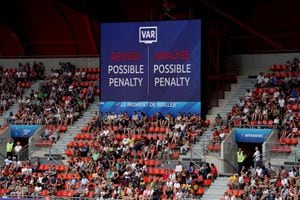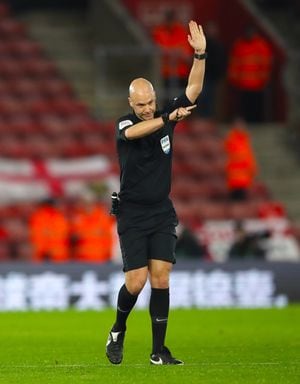Sky Sports' Johnny Phillips: Officials make case for VAR’s Prem bow
The Premier League steps into the unknown this weekend with the roll out of VAR (video assistant referees).
It will bring a profound difference to the way supporters engage in live football. It will be impossible to watch the match without awareness that VAR is in the background.
On Wednesday morning there was the opportunity to see how the system will be rolled out. A stone’s throw from Heathrow Airport at IMG Studios, Premier League Productions’ headquarters, those who have been working on VAR’s implementation for over two years presented a seminar. Premier League director of football Richard Garlick, former referee and head of VAR implementation Neil Swarbrick, and VAR project manager Harry Todd gave a fascinating insight into the workings of the system. This included an opportunity to enter the VAR hub, a room where seven stations are set up to cover games simultaneously, with the capacity to rise to 10 when all matches kick off at the same time on the final day of the season.
The VAR will watch on a large screen, with four other smaller screens showing the match on a three-second delay. This gives the opportunity to make judgements in an ‘almost-live’ scenario and check straight forward issues as play continues. Swarbrick was keen to stress that the system tested involves ‘minimal interference’. He was the ideal representative to speak about VAR. Referees sometimes cop a bad press and there are some who could be accused of basking in the glare of publicity, but Swarbrick’s humility and pragmatism was perfect for this seminar.
He was also candid enough to admit that VAR’s use in the last men’s and women’s World Cup finals was flawed. In 2018 we saw the final of the men’s game, between Croatia and France, adversely affected by the award of a penalty to France following an accidental handball by a Croatian defender, with the game tied at 1-1. In the Premier League, the referees will not be rushing to award penalties for handball when defenders are clearly being struck by the ball accidentally.
At the Women’s World Cup, where VAR was a shambles, the officials had only been told they would be implementing VAR at the finals six months earlier. As a result, they were woefully underprepared for its use in a major finals.
The Premier League wants to set a ‘high bar’ for overturning on-field decisions, in theory leading to very few decisions being reversed. The message was clear, that VARs would not be re-refereeing the matches. The key to its success will, in all likelihood, be illustrated best in the application of the ‘clear and obvious error’ part of the application.

Wolves fans will remember Manchester United’s Victor Lindelof being sent off for a rash challenge on Diogo Jota during last season’s FA Cup quarter-final. Referee Martin Atkinson consulted his linesman, who was convinced it was a red card. The VAR overturned the decision, despite there being no clear and obvious error. Swarbrick admitted VAR got that particular incident wrong, partly because the linesman stated Lindelof was making no attempt to play the ball, rather than emphasising the reckless nature of the foul. The replay showed Lindelof missed the ball by a fraction so VAR overturned the decision on the basis that the linesman did not see this. If he had said the foul was a reckless challenge then the decision might not have been reversed.
Swarbrick was clear that these tight subjective calls will not be overturned. The same foul may be seen by one referee as a borderline yellow card and another as a borderline red card. In either case, where the foul is open to subjective interpretation, unless there is a clear and obvious error, then the decision would not be reversed.
One concern, which I am not comfortable with, is the resetting of phases of play. When Naby Keita scored for Liverpool last season at Southampton it followed a much earlier offside against Mo Salah in the build-up. We watched a replay of this and Swarbrick explained that, because Southampton’s defence had the opportunity to reset on a couple of occasions in between the offside and the goal, the VAR would not rule the goal out for the original offside. Swarbrick informed us that all 20 Premier League clubs were shown this example and 19 were happy with this interpretation. Southampton were the only ones to object. Even so, it seems dangerous for VAR to be the judge of when play should be reset. Only those defenders on the pitch know if they are back in a position they are comfortable with.
Another issue is the use of slow motion replays. Any replay not shown at live speed distorts reality. VARs will watch incidents back at full speed to establish the intensity of the situation, be it a tackle or handball. Then slow-motion replays are used to establish more information, which seems sensible enough. But it would surely be fairer if the ‘super’ slow motion replays were completely ignored. These specific replays are just too far removed from actual time and nearly always make tackles look worse than they are.
Supporters will be kept informed on the big screens at 18 of the Premier League grounds – Liverpool and Manchester United do not have screens – and the defining replay will be shown to spectators to clarify where judgements have been made. Informing fans inside the stadium is a high priority.
Offside decisions are where VAR should make the biggest difference. Last season VAR would have overturned 41 cases that played a part in the awarding or disallowing of a goal. The Referee Review Area at the side of the pitch will not become the focus of much attention, though, and Swarbrick hopes officials’ visits to the screens will be few and far between.

Leaving the studios in Stockley Park, it was clear that the Premier League and PGMOL are doing everything in their power to make VAR a success. Not to mention the huge costs involved, with extra outside broadcast cameras needed and the impressive VAR headquarters itself.
The personal preference has not changed. The organic nature and spontaneity of football is not best served by VAR.Occasional refereeing errors are a small price to pay in maintaining the quality of such a free-flowing sport, where the intensity and pace is allowed to build as the game develops. VAR can kill this in an instant.
But now it is here, there is no doubt the Premier League and PGMOL deserve great credit for doing everything in their power to ensure the changes are brought in with as little disruption as possible. Maybe over time, the doubters will grow to accept it.
For now, at least, VAR deserves the opportunity to make its case.





